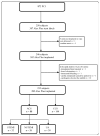48-Month Clinical Outcomes and Prognostic Factors in an All-Comers Population with Acute Coronary Syndrome and Chronic Coronary Syndrome Undergoing Percutaneous Coronary Intervention with a Sirolimus-Eluting Stent
- PMID: 38003888
- PMCID: PMC10672598
- DOI: 10.3390/jpm13111573
48-Month Clinical Outcomes and Prognostic Factors in an All-Comers Population with Acute Coronary Syndrome and Chronic Coronary Syndrome Undergoing Percutaneous Coronary Intervention with a Sirolimus-Eluting Stent
Abstract
We characterized the performance as well as safety of a second-generation thin-strut sirolimus-eluting stent with a biodegradable polymer, Alex Plus (Balton, Poland), deployed in the acute coronary syndrome (ACS) setting. We enrolled patients who were subjected to percutaneous coronary intervention (PCI) between July 2015 and March 2016 and took into consideration demographics, clinical and laboratory data, and clinical outcomes. We defined the primary endpoint as the 48-month rate of major cardiovascular adverse events (MACE), including cardiac death, myocardial infarction (MI), or target lesion revascularization (TLR). The secondary endpoints were all-cause death, cardiac death, MI, and TLR rates at 12-, 24-, 36-, and 48 months. We enrolled 232 patients in whom 282 stents were implanted, including 88 ACS and 144 chronic coronary syndrome (CCS) patients. The mean age of the ACS population was 67 ± 13 years old, and 32% of it consisted of females. Patients with ACS were characterized by lower rates of arterial hypertension (85.2% vs. 95.8%, p = 0.004), dyslipidemia (67% vs. 81.9%, p = 0.01), prior MI (34.1% vs. 57.6%, p < 0.001), and prior PCI (35.2% vs. 68.8%, p < 0.001). At 48 months, among the ACS patients, the rates of MACE, death, cardiac death, MI, and TLR were 23.9%, 11.4%, 7.9%, 9.1%, and 10.2%, respectively. No stent thrombosis cases were reported. Multivariable Cox regression revealed that the statistically significant MACE predictors were massive calcifications in coronary arteries (HR 9.0, 95% CI 1.75-46.3, p = 0.009), post-dilatation (HR 3.78, 95% CI 1.28-11.2, p = 0.016), prior CABG (HR 6.64, 95% CI 1.62-27.1, p = 0.008), vitamin K antagonist use (HR 5.99, 95% CI 1.29-27.8, p = 0.022), and rivaroxaban use (HR 51.7, 95% CI 4.48-596, p = 0.002). The study findings show that Alex Plus was effective and safe in a contemporary cohort of real-world ACS patients undergoing primary PCI. The outcomes were comparable between the ACS and chronic coronary syndrome patients, with a trend of lower TLR in ACS patients at 4 years.
Keywords: ACS; Alex Plus; PCI; SES; in-stent restenosis; target lesion revascularization; thin-strut stent.
Conflict of interest statement
The authors declare no conflict of interest.
Figures


Similar articles
-
Percutaneous Coronary Interventions with Sirolimus-Eluting Alex Plus Stents in Patients with or without Diabetes: 4-Year Results.J Cardiovasc Dev Dis. 2024 May 22;11(6):160. doi: 10.3390/jcdd11060160. J Cardiovasc Dev Dis. 2024. PMID: 38921660 Free PMC article.
-
Improved safety and reduction in stent thrombosis associated with biodegradable polymer-based biolimus-eluting stents versus durable polymer-based sirolimus-eluting stents in patients with coronary artery disease: final 5-year report of the LEADERS (Limus Eluted From A Durable Versus ERodable Stent Coating) randomized, noninferiority trial.JACC Cardiovasc Interv. 2013 Aug;6(8):777-89. doi: 10.1016/j.jcin.2013.04.011. JACC Cardiovasc Interv. 2013. PMID: 23968698 Clinical Trial.
-
Subgroup Analysis Comparing Ultrathin, Bioresorbable Polymer Sirolimus-Eluting Stents Versus Thin, Durable Polymer Everolimus-Eluting Stents in Acute Coronary Syndrome Patients.Circ Cardiovasc Interv. 2018 Oct;11(10):e007331. doi: 10.1161/CIRCINTERVENTIONS.118.007331. Circ Cardiovasc Interv. 2018. PMID: 30354631 Clinical Trial.
-
Efficacy and Safety of TiNO-Coated Stents versus Drug-Eluting Stents in Acute Coronary Syndrome: Systematic Literature Review and Meta-Analysis.Biomedicines. 2022 Dec 7;10(12):3159. doi: 10.3390/biomedicines10123159. Biomedicines. 2022. PMID: 36551915 Free PMC article. Review.
-
Prognostic value of elevated lipoprotein (a) in patients with acute coronary syndromes: a systematic review and meta-analysis.Front Cardiovasc Med. 2024 May 9;11:1362893. doi: 10.3389/fcvm.2024.1362893. eCollection 2024. Front Cardiovasc Med. 2024. PMID: 38784168 Free PMC article.
Cited by
-
Percutaneous Coronary Interventions with Sirolimus-Eluting Alex Plus Stents in Patients with or without Diabetes: 4-Year Results.J Cardiovasc Dev Dis. 2024 May 22;11(6):160. doi: 10.3390/jcdd11060160. J Cardiovasc Dev Dis. 2024. PMID: 38921660 Free PMC article.
References
-
- Thygesen K., Alpert J.S., Jaffe A.S., Chaitman B.R., Bax J.J., Morrow D.A., White H.D., Executive Group on behalf of the Joint European Society of Cardiology (ESC)/American College of Cardiology (ACC)/American Heart Association (AHA)/World Heart Federation (WHF) Task Force for the Universal Definition of Myocardial Infarction Fourth universal definition of myocardial infarction (2018) Eur. Heart J. 2019;40:237–269. doi: 10.1093/eurheartj/ehy462. - DOI - PubMed
-
- Higuma T., Soeda T., Abe N., Yamada M., Yokoyama H., Shibutani S., Vergallo R., Minami Y., Ong D.S., Lee H., et al. A Combined Optical Coherence Tomography and Intravascular Ultrasound Study on Plaque Rupture, Plaque Erosion, and Calcified Nodule in Patients With ST-Segment Elevation Myocardial Infarction: Incidence, Morphologic Characteristics, and Outcomes After Percutaneous Coronary Intervention. JACC Cardiovasc. Interv. 2015;8:1166–1176. doi: 10.1016/j.jcin.2015.02.026. - DOI - PubMed
-
- Omer M.A., Tyler J.M., Henry T.D., Garberich R., Sharkey S.W., Schmidt C.W., Henry J.T., Eckman P., Megaly M., Brilakis E.S., et al. Clinical Characteristics and Outcomes of STEMI Patients With Cardiogenic Shock and Cardiac Arrest. JACC Cardiovasc. Interv. 2020;13:1211–1219. doi: 10.1016/j.jcin.2020.04.004. - DOI - PubMed
-
- Collet J.P., Thiele H., Barbato E., Barthelemy O., Bauersachs J., Bhatt D.L., Dendale P., Dorobantu M., Edvardsen T., Folliguet T., et al. 2020 ESC Guidelines for the management of acute coronary syndromes in patients presenting without persistent ST-segment elevation. Eur. Heart J. 2021;42:1289–1367. doi: 10.1093/eurheartj/ehaa575. - DOI - PubMed
LinkOut - more resources
Full Text Sources
Miscellaneous

